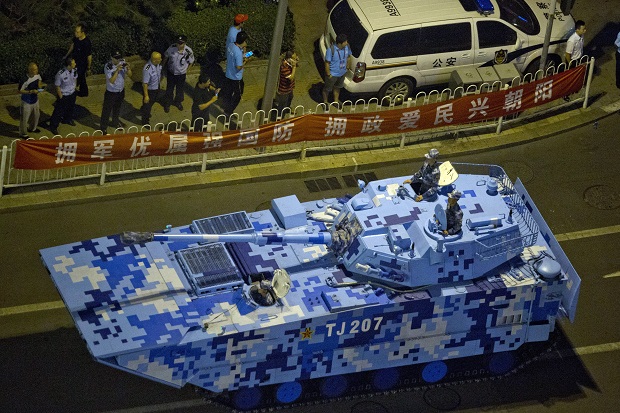China to flex military muscle in WWII parade

In this Aug. 22, 2015 file photo, Chinese police men stand guard as a Chinese military tank rolls down a main avenue during a rehearsal at night ahead of the Sept. 3 military parade to commemorate the end of World War II in Beijing. China will hold a massive military parade through the heart of its capital, but ordinary folks can’t watch. Authorities obsessed with security and leery of any possible hitches will virtually shut down central Beijing on Thursday, Sept. 3, keeping most people out of eyeshot for the parade commemorating the defeat of Japan in World War II. Residents who live along the parade route have received notices ordering them to stay off balconies, keep windows shut, invite no guests and – at some buildings – snap no pictures. AP Photo
BEIJING, China—A huge military parade rolls through Tiananmen Square on Thursday as Beijing commemorates the 70th anniversary of Japan’s WWII defeat, but major Western leaders are staying away from the show of strength.
READ: China’s WWII military parade a show of strength
President Xi Jinping will oversee the spectacle featuring 12,000 Chinese soldiers, 500 pieces of hardware and almost 200 aircraft, which comes as Beijing takes a more assertive diplomatic stance.
READ: Key Western leaders stay away from China WWII military parade
Key leaders from Western democracies will be absent, such as US President Barack Obama, German Chancellor Angela Merkel and Japanese Prime Minister Shinzo Abe, who has drawn Beijing’s ire for beefing up his country’s security policies.
Article continues after this advertisementXi is China’s commander-in-chief as the chairman of the Communist Party’s Central Military Commission, since the People’s Liberation Army (PLA) is technically the armed force of the Party.
Article continues after this advertisementUnder him, Beijing is moving farther away from former leader Deng Xiaoping’s dictum to “hide one’s capabilities, bide one’s time” and is becoming more willing to take harder lines, both externally and against domestic opponents.
It is engaged in high-profile maritime disputes with neighbors in the South China Sea, where it is building artificial islands and facilities with military uses, and with Japan over disputed outcrops.
John Delury, an expert on China at Yonsei University in Seoul, told AFP the limited international guest list was because “it’s a very nationalistic and militaristic event.”
“Across Asia and certainly in the United States there are all these concerns about the hard power side of China’s rise,” he said.
Military display
The PLA has promised that 84 percent of the equipment on display will be seen in public for the first time.
According to state media, carrier-based aircraft, long distance bombers and various missiles will be shown—possibly including the DF-21D, a long-rumored ballistic “carrier-killer” that could change the balance of power in the Pacific Ocean.
But Chinese foreign ministry spokeswoman Hua Chunying said those viewing the parade as an aggressive gesture had “a mentality that is not so bright.”
“The Chinese troops are troops for peace” she told a regular briefing. “The stronger this kind of force grows, the more guarantees it will be able to provide for world peace.”
Almost 1,000 foreign soldiers will also take part, including a Russian detachment, and President Vladimir Putin is by far the most high-profile foreign leader.
Xi went to a similar event in Moscow in May, which was also shunned by major Western leaders over the annexation of Crimea and fighting in eastern Ukraine.
More mainstream guests include South Korea’s Park Geun-Hye, whose country was colonized by Japan, Jacob Zuma of South Africa—which with China is part of the BRICS groups of major emerging economies—and UN Secretary General Ban Ki-moon. French Foreign Minister Laurent Fabius will also attend.
China has held military parades roughly once a decade but previously for the foundation of the People’s Republic on October 1.
Thursday’s parade comes the day after Japan formally surrendered 70 years ago on the USS Missouri in Tokyo Bay, which Beijing marks as the end of the “Chinese People’s War of Resistance against Japanese Aggression and the World Anti-Fascist War,” as it officially calls the conflict.